
Feet and hands are likely the two most avoided body parts by beginning artists. Sure, any bit of human anatomy presents a set of challenges, but hands and feet are considered by some to be the "hardest to draw".
Some folks will even go to great lengths to avoid drawing feet. They may purposely leave them out of a drawing or cover them up with overgrown grass blades.
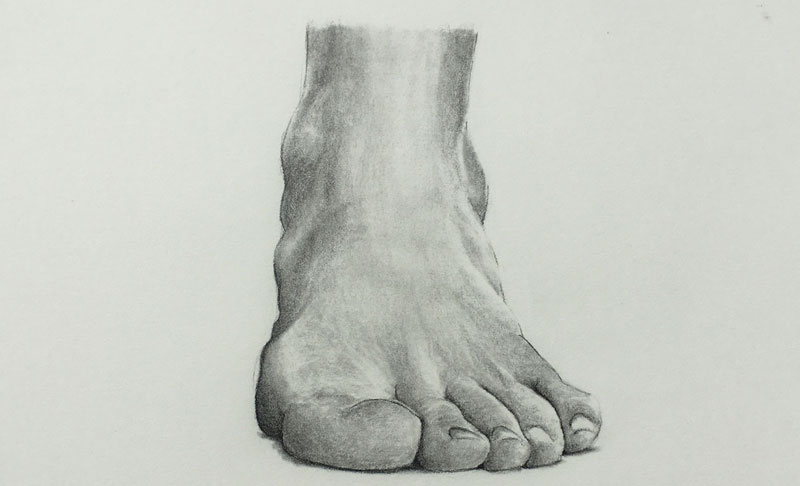
But drawing feet is just like drawing any other subject. We simply need to observe the feet and look for basic shapes and forms to draw. When we find them and draw them first, the contour lines are much easier to draw. With a bit of value and tone, the texture and form of the feet can be developed.
The following video explains a simple approach to drawing feet. This approach uses three basic forms that anyone can draw. When these three forms are recognized and pieced together, the process becomes much easier.
The human body is a complex subject. The bone structure and muscles underneath the skin play a role in the subtle changes of tone that affect the representational qualities of the drawing. Knowing the anatomical structure certainly helps, but it's not required knowledge to draw a convincing foot.
We can simplify the process by recognized three basic forms. These basic forms can be found on any foot in just about any position. If we practice recognizing these forms and drawing them, then drawing feet actually becomes a much easier endeavor.
The first basic form is perhaps the easiest to recognize. It is the wedge that exists in the middle portion of the foot. Typically, this is the first form that is drawn since the other two forms extend off from it. This wedge form makes up the bulk of the foot and it helps to determine the angle and direction of the rest of the foot.
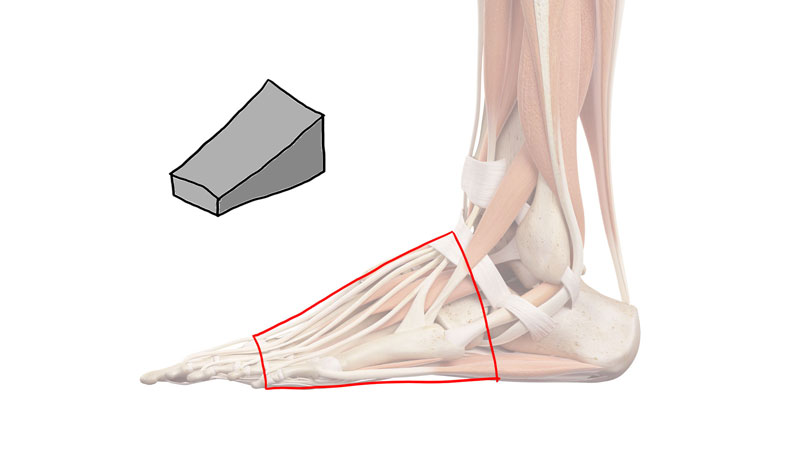
This wedge is taller towards the heel and slants downward toward the toes. When drawing these basic forms, you can be loose with the lines that you draw. We'll refine the edges and the contours once we have all of the basic forms in place.
The second form is drawn in the location of the toes. This form connects with the end of the wedge and resembles a flattened, partial cylinder. If the toes are viewed from the front or directly from the side, this form may appear as a simple rectangle.
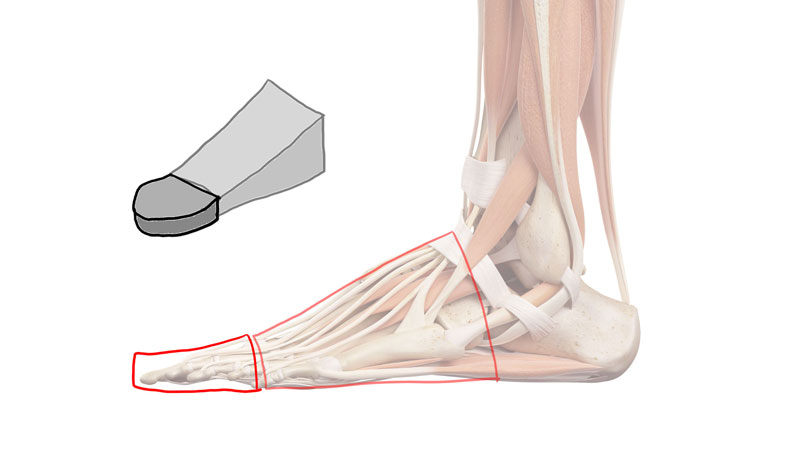
You may think of this form as the end of a shoe, which makes perfect sense. Remember, at this stage of the drawing, we are only concerned with these simple forms. Be sure that your aren't distracted by the details. We'll add the details after these forms are in place.
The third form is for the heel of the foot. This forms extends from the opposite end of the wedge. It is a much taller partial cylinder that is flattened on the sides.
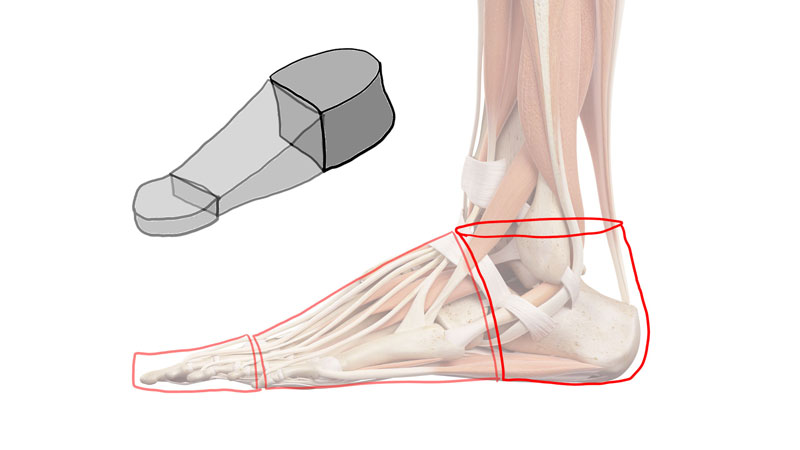
Once we have the basic forms in place, we can next turn our attention to defining the contour lines or outlines. If we started with the contours, then we are more likely to run into issues with accuracy.
These three basic forms can be recognized and drawn when the foot is in any position. The forms may change slightly depending on the specific angle, but they are still easy to find.
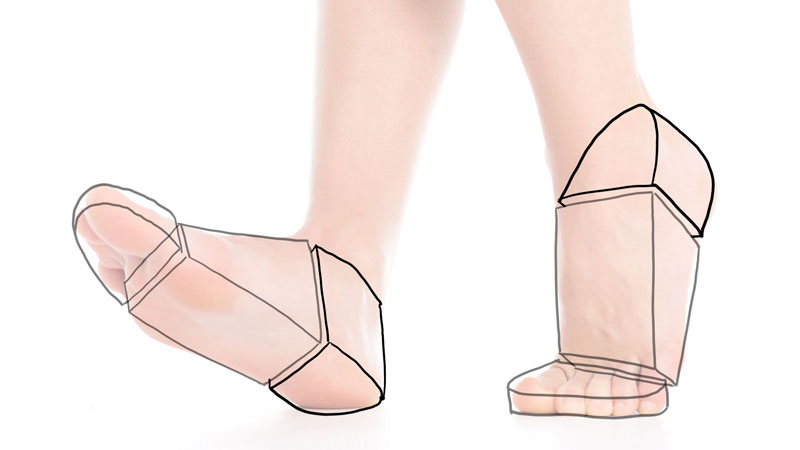
The contour lines or outlines define the edges of the feet. These lines can be drawn with added confidence because we now have the overall form of the foot in place. We can pay closer attention to the subtle curves and bumps that occur.
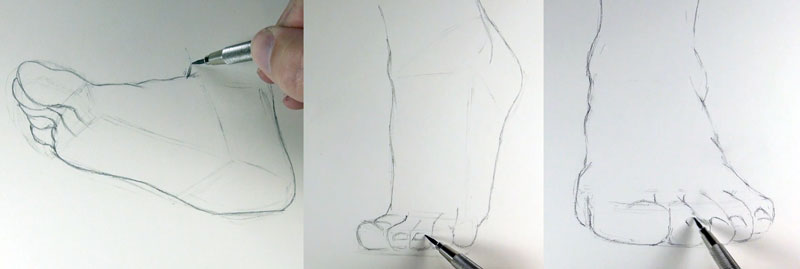
The toes fit nicely in the form that we have drawn for them. The line where the wedge meets the form can also be used as a guideline for where the toes meet the middle portion of the foot. In most circumstances, this line curves slightly. The second toe usually extends out the most. The toes then become shorter making their way back to the wedge.
The illusion of form is created through the development of a range of value. We often refer to this part of the process as shading. We aren't just considering the shades though, but also the lighter values. The positioning of these tones creates the illusion of the light source, which informs the viewer of the form.
In each one of these examples, we are faced with dual light sources. (In most circumstances, there is more than one light source.) We have a dominant light source that originates from the right and a weaker one that originates from the left. This produces stronger highlights on the right side and stronger shadows on the left.
We can also consider that in most situations, areas that recede away from the viewer are typically darker in value, while locations that protrude towards the viewer pick up more light and are lighter in value. This means that even on the side of the foot that is closest to the dominant light source, we find some areas of darker tone.
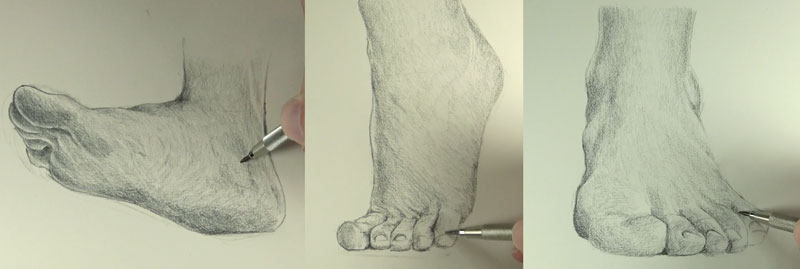
As the graphite is applied to the drawing with a pencil, we'll need to consider the form of the foot. Directional strokes should flow around the surface in a manner that mimics the form. These directional strokes are not unlike cross contour lines. By adding the graphite in this way, we are addressing not only the tonality, but also the form.
The texture of the foot is developed by smoothing transitions of tone and value with the use of a blending stump. The directional strokes made with the blending stump should mimic those made with the pencil. As the form changes, the stroke should as well.
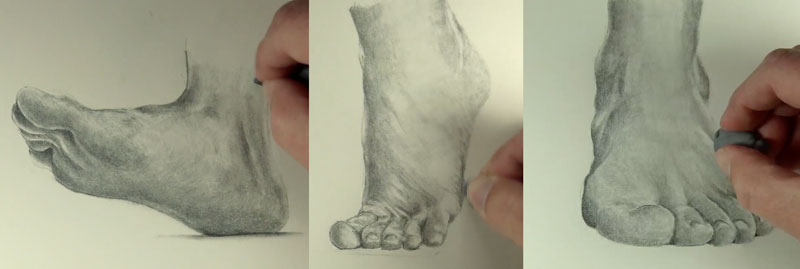
Lighter values and highlights can be pulled or lifted from the surface with a kneaded eraser. The combination of smoothing graphite applications and removing bits of highlight with the kneaded eraser often leads to a convincing illusion of skin.
After the tones and texture have been addressed, we can strengthen the contrast and refine the edges with a sharpened graphite pencil. Around the edges, only the areas of darker value are reinforced with additional lines.
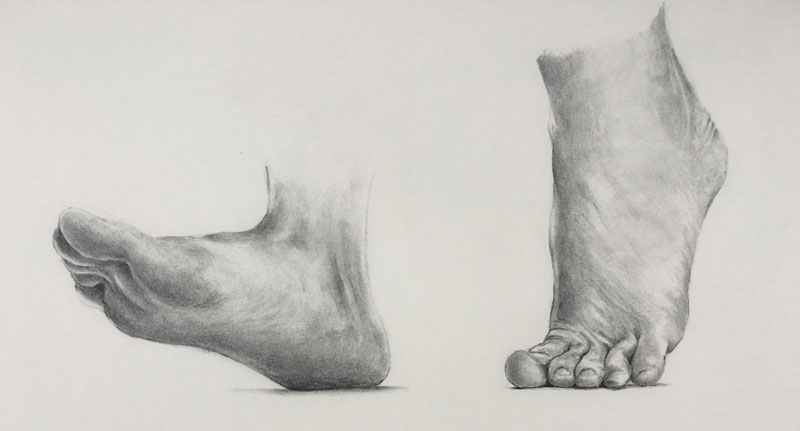
Edges of the foot that are highlighted are left open with implied lines defining the edge. These last few lines complete the drawing.

Drawing feet doesn't have to be difficult. We can remove many of the complexities by just learning to recognize the basic forms that are present. By drawing these forms loosely in the beginning stages of the drawing, we are free to focus on the contour lines with confidence. With the contour lines in place, all that's left to do is add a bit of value and texture.